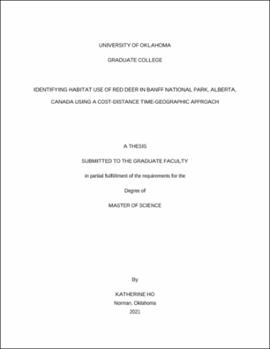| dc.contributor.advisor | Loraamm, Rebecca | |
| dc.contributor.author | Ho, Katherine | |
| dc.date.accessioned | 2021-08-03T18:53:51Z | |
| dc.date.available | 2021-08-03T18:53:51Z | |
| dc.date.issued | 2021-08 | |
| dc.identifier.uri | https://hdl.handle.net/11244/330191 | |
| dc.description.abstract | The expressed movements of animals are realizations of complex spatiotemporal processes. The varied environmental contexts (such as varying topography or landcover) in which animals move are central to these processes, fundamentally modulating the movements of individuals through space. As an emerging perspective in the time-geographic study of movement, direct examination of the influence that varying context may have on observed movements yields actionable information to wildlife management, planning and conservation. In support of these pursuits, this research develops a practical extension of a new cost-distance-based, probabilistic voxel space-time prism (CDBPSTP) in efforts to more realistically characterize the unobserved habitat occupancies of animals occurring between the instantaneous positions provided by location-aware technologies. The first chapter of this work frames the scope of my research with a literature review of time geography, particularly in the context of animal movement, habitat selection methods, and recent developments in computational time-geographic methods. The second chapter presents the research completed, “Identifying Habitat Use of Red Deer in Banff National Park, Alberta Canada using a Cost-Distance Time-Geographic Approach,” wherein the CDBPSTP is evaluated on trajectory data collected for a group of Red Deer (Cervus elaphus) tracked near Banff National Park, Alberta, Canada. As a demonstration of the added value offered in examining the influence of context on movement, CDBPSTP habitat occupancy results are compared to the earlier PSTP method in context with empirical and theoretical understandings of Red Deer habitat preference and space-use behaviors. We found that CDBPSTP as-demonstrated offers an alternative construction of the space-time prism that advances time geographic research; CDBPSTP provides a pathway towards a reasonable incorporation of context in probabilistic space-time prism modeling. The third chapter presents an extended discussion that situates the place of CDBPSTP within time-geographic literature, addresses limitations to this study, and proposes avenues of related future research. | en_US |
| dc.language | en_US | en_US |
| dc.rights | Attribution-ShareAlike 4.0 International | * |
| dc.rights.uri | https://creativecommons.org/licenses/by-sa/4.0/ | * |
| dc.subject | time-geography | en_US |
| dc.subject | animal movement | en_US |
| dc.subject | red deer | en_US |
| dc.subject | habitat use | en_US |
| dc.title | Identifying habitat use of red deer in Banff National Park, Alberta, Canada using a cost-distance time-geographic approach | en_US |
| dc.contributor.committeeMember | Neeson, Thomas | |
| dc.contributor.committeeMember | Wimberly, Michael | |
| dc.date.manuscript | 2021-07 | |
| dc.thesis.degree | Master of Science in Geography | en_US |
| ou.group | College of Atmospheric and Geographic Sciences::Department of Geography and Environmental Sustainability | en_US |

